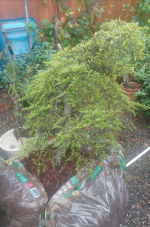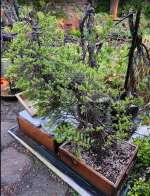Lodgepoles can be kept alive with a minimum of roots, so I was never tempted to prune those.
Spruces and fir are likewise pretty durable, so I have only top pruned a couple especially luxuriant spruces, both with success.
It's really the mountain hemlocks that come with a lot of foliage and makes me want to try top pruning. The very old big hemlocks worth collecting typically have 2-3 very large tap roots 1-2" in diameter and so you are at the mercy of what local fine roots there happen to be.
This was the 3rd time I top pruned a hemlock, in Oct 2023. As collected with
@Ruddigger. I was initially worried because we severed two 1" tap roots and the tree had a lot of foliage:

I don't have good records but I took most of the longest extensions back and also topped the tree.

styled in 2024

...and again by ruddigger a few weeks ago

New this year I collected a rather young clump. The young trees like this are easy to collect because they haven't formed a massive tap root yet. In this case I only had to cut a couple 1/2" roots.

Nevertheless, in the spirit of the study I have taken back all of the apexes (they were going to be removed later anyway) as well as all the extraneous extensions. I will be very shocked if this one doesn't make it.

And here is a middle aged solitary tree that is quite ramified. This one required severing one 1" tap root and one 2" tap root, but it had above average local roots, so I am hopeful. This pic is actually after I removed the apex and most of the extensions:

After further removing extensions: The tree still has hundreds of growth points but is more in balance with the root ball.

If I have time it would be good to do a controlled study. Something like 4 identical-ish trees with different top treatments. Try doing a significant (75%) top prune on one to see what happens.








